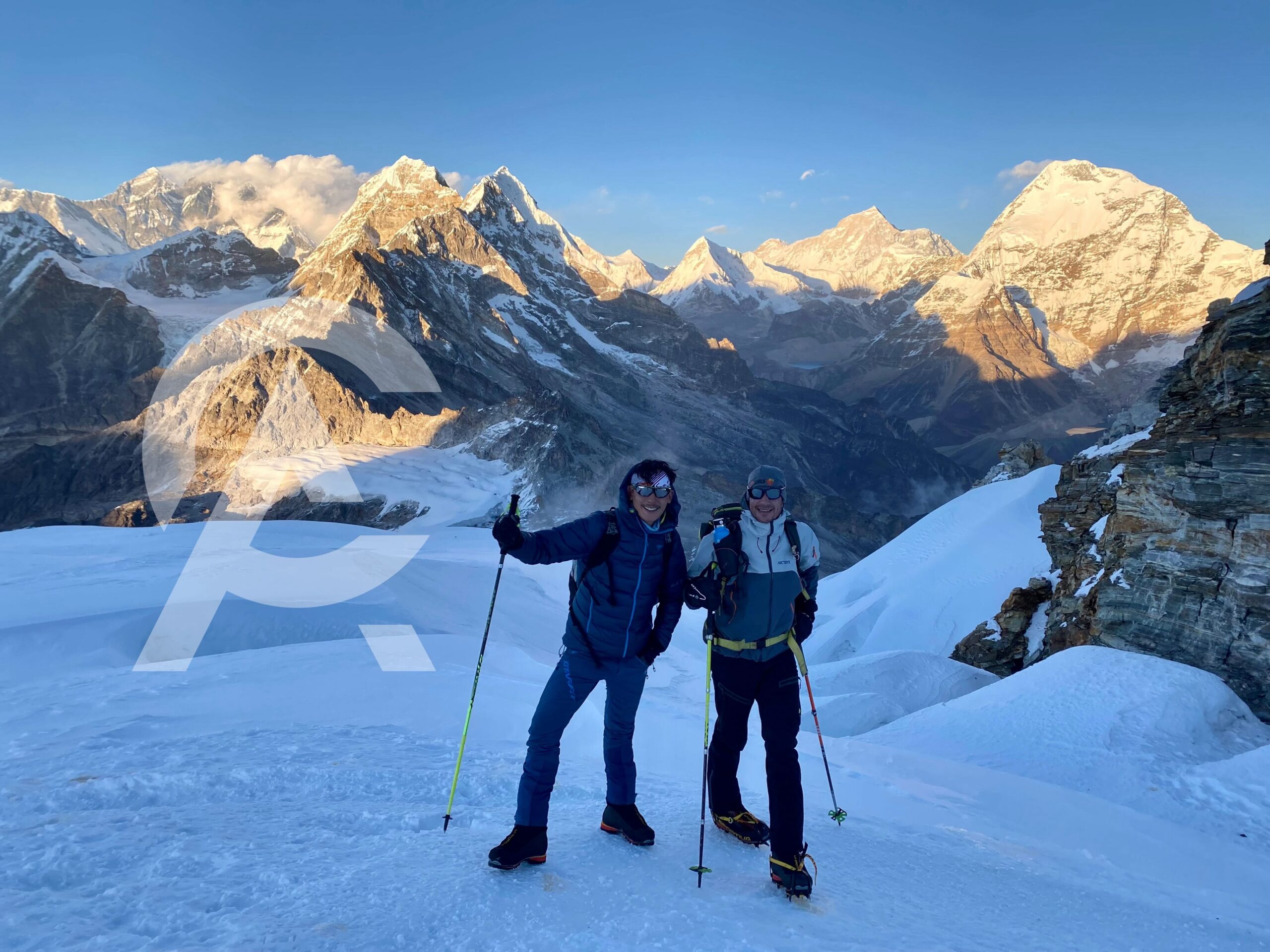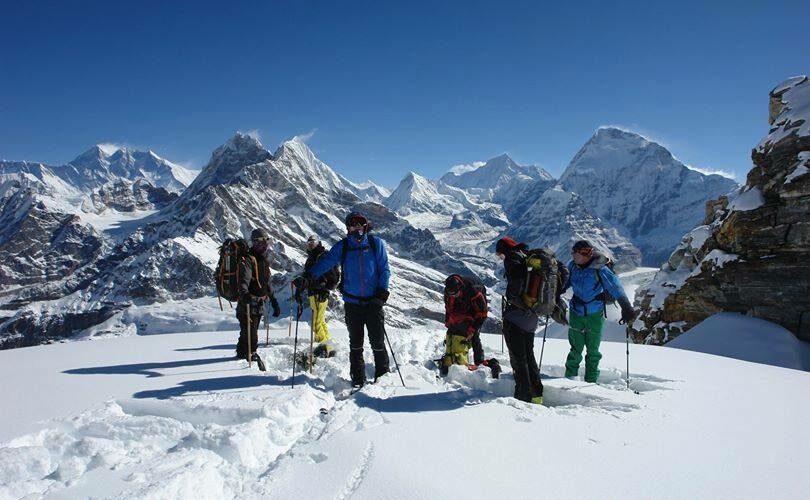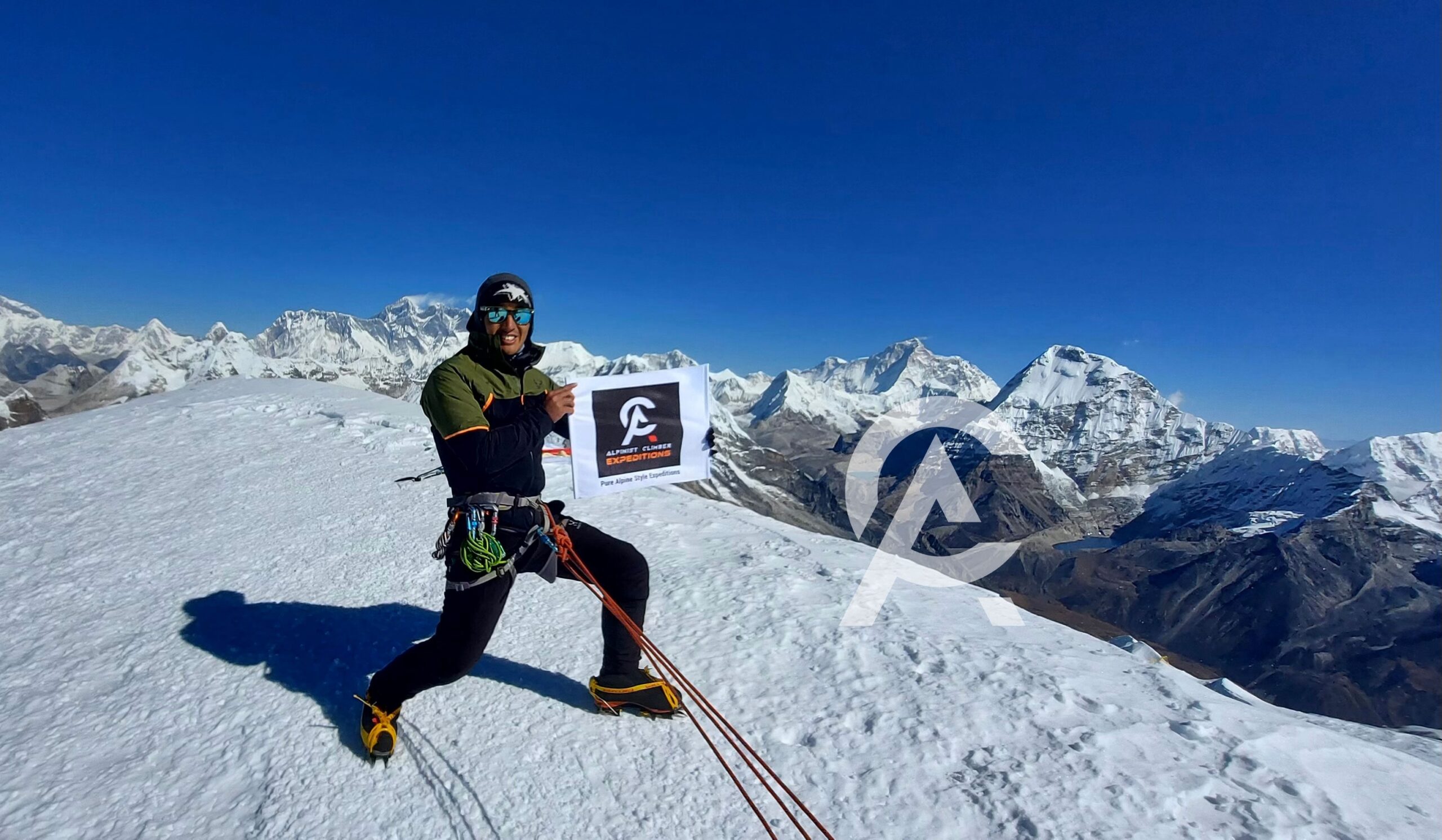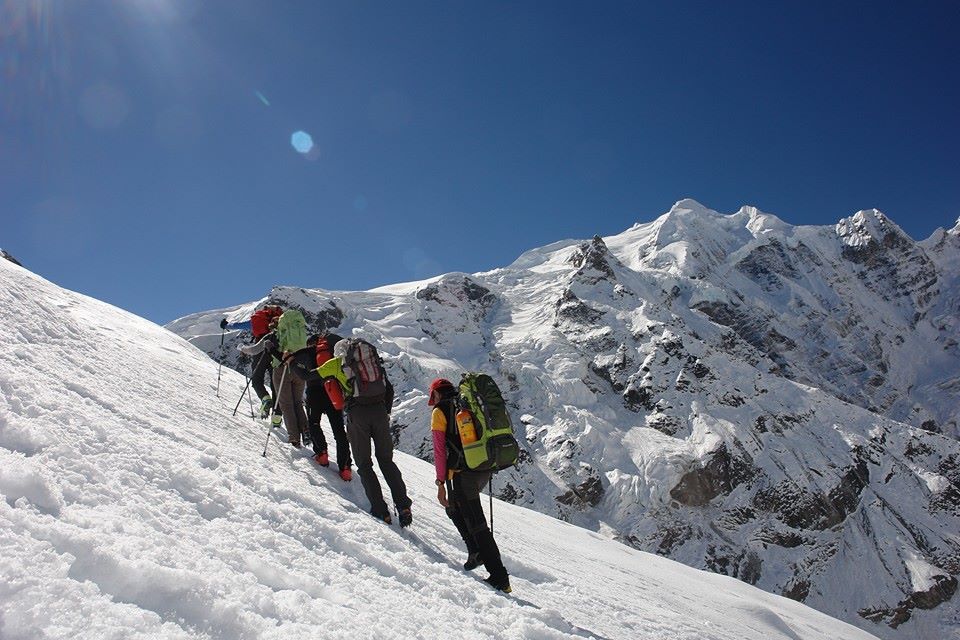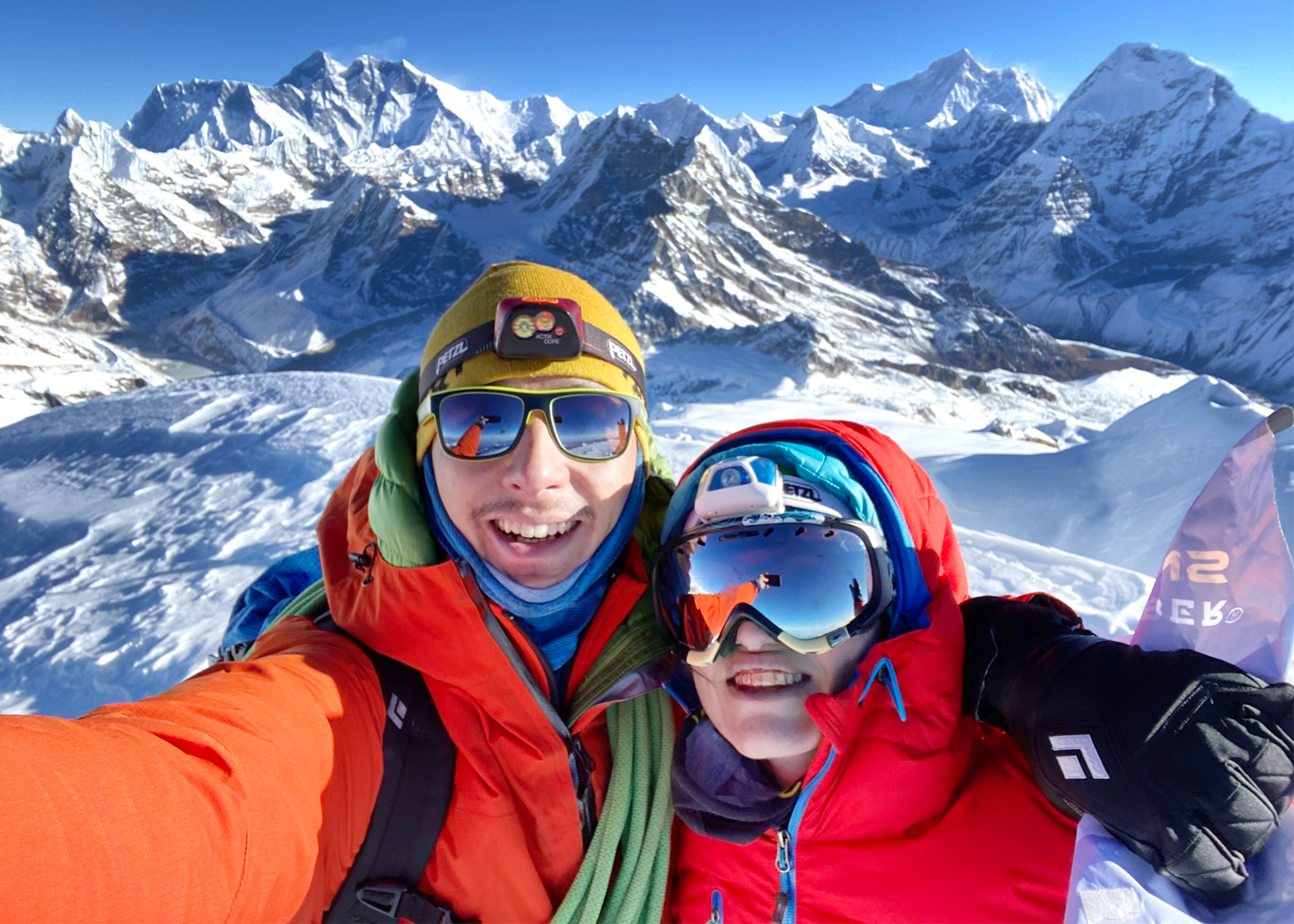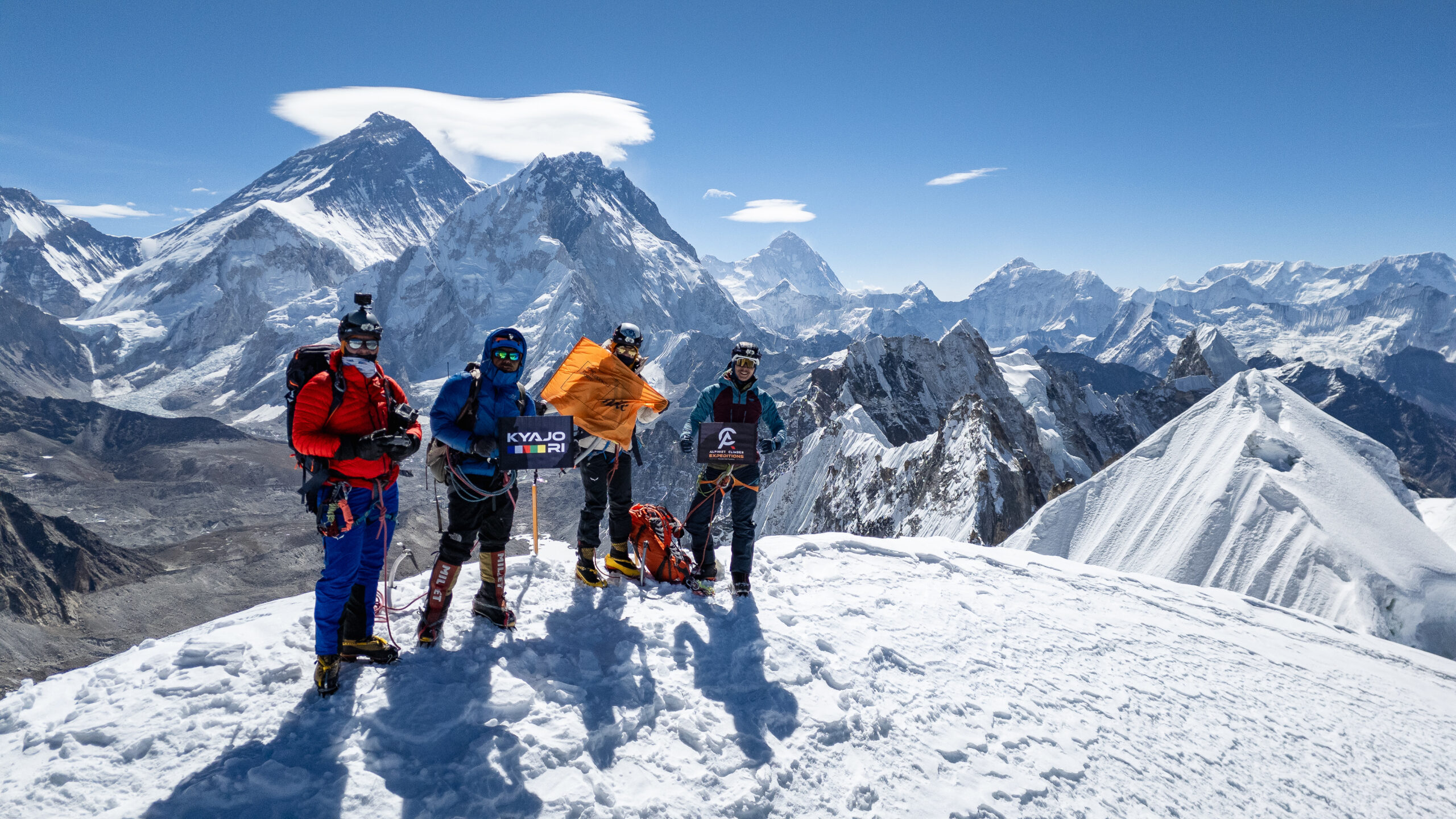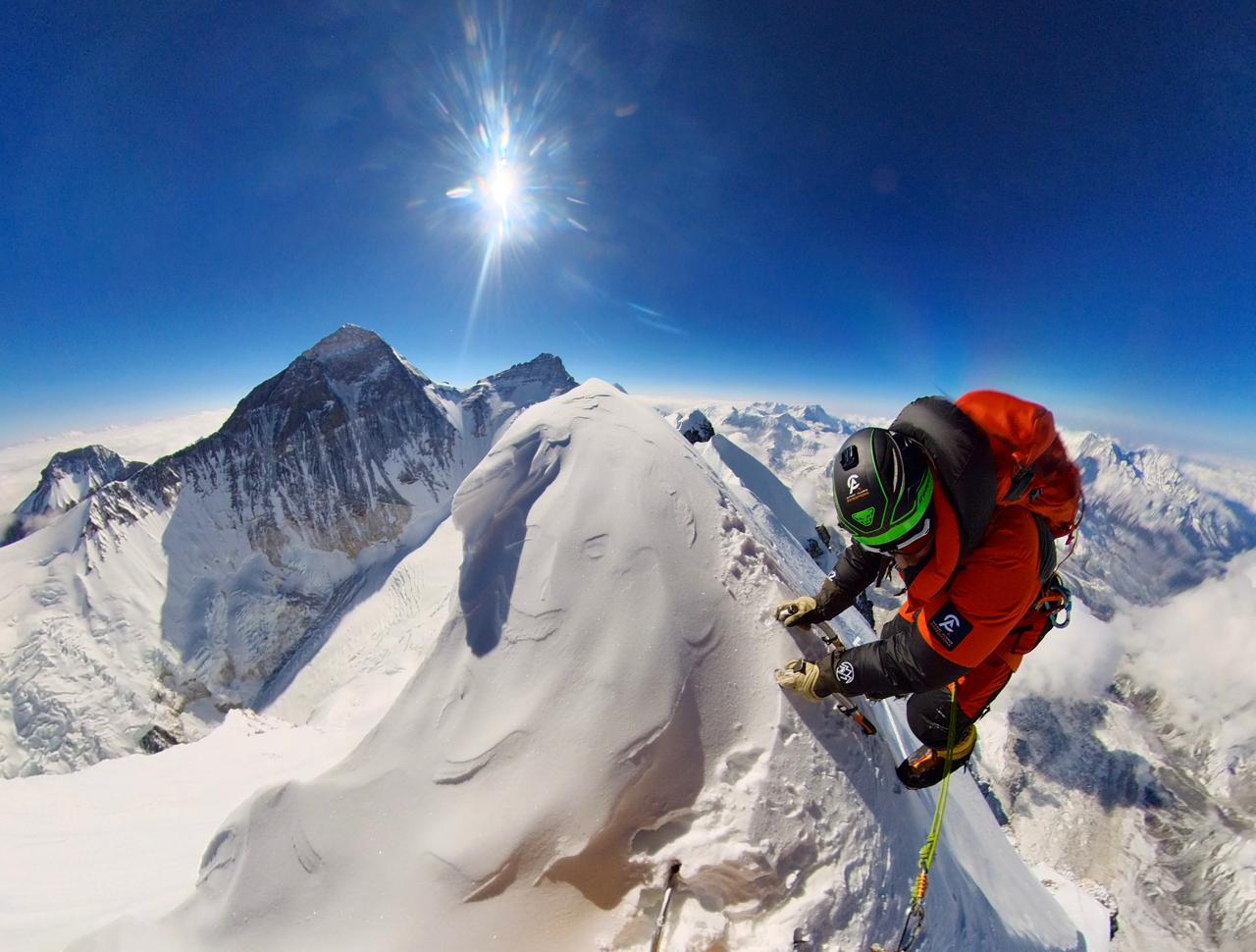Mera Peak Luxury Expedition
Mera Peak is a renowned trekking and climbing destination in Nepal, known for its stunning views of some of the world’s highest peaks, including Mount Everest, Makalu, Kanchanjunga, Cho Oyu and Lhotse. Standing at 6,476 meters, it is considered one of the highest trekking peaks in Nepal.
Nepal is a country of remarkable cultural, ethnic, and linguistic diversity, largely due to its geographic, historical, and social complexities. Nestled between India and China, Nepal’s diversity is shaped by its varied topography. Which ranges from the lowland Terai plains to the towering Himalayas. This diversity is reflected in its people, languages, religions, traditions, and ways of life.
Difficulty Level
Moderate
Best Season
Autumn & Spring
Duration
16 days
Elevation
6,476m
Group Size
2 - 6
Trip Type
6000M Expedition
2025
6000M Expedition
- Departs from Kathmandu, Nepal
Overview
Mera Peak is a renowned trekking and climbing destination in Nepal, known for its stunning views of some of the world’s highest peaks, including Mount Everest, Makalu, Kanchanjunga, Cho Oyu and Lhotse. Standing at 6,476 meters, it is considered one of the highest trekking peaks in Nepal, making it accessible climb for experienced and beginner mountaineers.
Nepal is a country of remarkable cultural, ethnic, and linguistic diversity, largely due to its geographic, historical, and social complexities. Nestled between India and China, Nepal’s diversity is shaped by its varied topography, which ranges from the lowland Terai plains to the towering Himalayas. This diversity is reflected in its people, languages, religions, traditions, and ways of life.
Ethnic Diversity.
Nepal is home to over 125 ethnic groups, each with its own distinct culture, language, and traditions. These groups can be broadly categorized into three main cultural regions:
Tibeto-Burman-speaking peoples: These groups primarily inhabit the Himalayan and hilly regions of Nepal. They are mostly Buddhists, though there are also Hindus among them. Key ethnic groups include:
- Sherpas: Famous for their mountaineering skills, especially in the Everest region.
- Gurung: Known for their warrior traditions and role in the British Gurkha regiments.
- Magar: One of the largest ethnic groups, they are concentrated in the mid-hills of Nepal and are often found in the military.
- Thakali: A smaller group known for their trading traditions, particularly in the Annapurna region.
Indo-Aryan-speaking peoples: These groups tend to live in the central and lowland Terai regions of Nepal and are primarily Hindu. Notable groups include:
- Brahmins and Chhetri: Historically dominant in Nepali society, especially in political and administrative spheres.
- Madhesi: People of Indian origin living in the southern Terai region, who share cultural and linguistic ties with the people of Bihar and Uttar Pradesh in India.
- Newars: An ethnic group native to the Kathmandu Valley, the Newars have a unique culture that blends both Hindu and Buddhist traditions, with distinct festivals, art, and cuisine.
Linguistic Diversity.
Nepal has over 120 languages spoken across its regions, belonging to several different language families:
- Indo-Aryan Language: Nepali, the official language, is the most widely spoken Indo-Aryan language. It is spoken by a majority of the population, but many other languages are also spoken, including Maithili, Bhojpuri, and Tharu, especially in the Terai region.
- Tibeto-Burman Languages: These languages are spoken in the mountainous and hilly regions of Nepal. Languages such as Sherpa, Tamang, Magar, Gurung, and Limbu are part of this family.
- Other Minority Languages: There are also other smaller languages spoken by indigenous groups.
The linguistic landscape of Nepal reflects the complex history of migration, trade, and cultural exchanges that have shaped the country over million.
Religious Diversity.
Nepal is a secular country with a majority Buddhist and Hindu population, but it is also home to significant Muslim, and Christian communities. Religion plays an integral role in the cultural and social life of the country.
- Buddhism: Buddhism is deeply rooted in Nepal, especially in the central and northern regions. The birthplace of the Buddha, *Lumbini*, is located in Nepal, making it a significant religious and pilgrimage site. The practice of Tibetan Buddhism is also widespread, particularly in the Himalayan regions, and Nepal hosts numerous monasteries and Buddhist stupas.
- Hinduism: Nepal’s population identifies as Hindu, making Nepal the only Hindu kingdom in the world until its transition to a republic in 2008. Hinduism influences almost every aspect of life, including festivals, rituals, and social structures. Major festivals like *Dashain* and *Tihar* are celebrated nationwide
- Islam: The Muslim community constitutes a small but growing portion of the population, primarily in the Terai region and among the urban population.
- Christianity: Although Christianity is a minority religion in Nepal, it has been growing in recent decades, especially in urban centers.
Cultural and Traditional Diversity.
Nepal’s cultural landscape is as varied as its people. Each ethnic group has its own traditional dress, music, dance, cuisine, and festivals.
- Cuisine: Nepali cuisine reflects the diverse ethnic groups and regions of the country. Popular dishes include *dal bhat* (lentils and rice), *momo* (dumplings), *sel roti* (sweet rice doughnut), and *thukpa* (noodle soup). The food culture in the Terai often has Indian influences, while food in the Himalayan regions is influenced by Tibetan traditions.
Festivals: Nepal’s festivals are also diverse and include:
- Buddha Purnima: Celebrating the birth, enlightenment of the Buddha, Vesak is also known as Buddha Jayanti, Buddha Purnima, and Saga Dawa Duchen. Observed mainly by Buddhist communities.
- Dashain: A major Hindu festival celebrated by all Nepalese communities, symbolizing the victory of good over evil.
- Tihar: A festival of lights celebrated by both Hindus and Newars.
- Indra Jatra: A Newar festival marking the harvest season with processions and rituals in Kathmandu.
Geographical and Ecological Diversity.
Nepal’s geography is divided into three major regions:
- The Himalayas: This region contains some of the highest peaks in the world, including Mount Everest, and is home to various ethnic groups like the Sherpas and Tibetans. The culture here is influenced by Tibetan and Sherpa Buddhism.
- The Hill Region: This central region contains the capital Kathmandu and is home to ethnic groups like the Magars, Gurungs, and Newars. It has a temperate climate and is rich in both Hindu and Buddhist cultural heritage.
- The Terai Region: A lowland region bordering India, it is home to the Madhesi people and is often compared to the Gangetic plains of India. The Terai is also where agriculture is the most developed, and it has a subtropical climate.
Political and Social Diversity.
Nepal has a long history of political and social transformation. It was once a monarchy, but following the end of the civil war and the establishment of a multi-party democracy in 1990, Nepal went through a prolonged period of political instability, culminating in the abolition of the monarchy in 2008. The country is now a federal democratic republic with a parliamentary system. The challenges of integrating its diverse ethnic, linguistic, and regional groups into a cohesive nation have been significant, but recent efforts toward federalism have sought to give more autonomy to regional and ethnic communities.
Indigenous Peoples and Rights.
Nepal has a large indigenous population, which includes the *Adivasi Janajatis* (indigenous nationalities), many of whom have fought for greater recognition and political rights. The country officially recognizes over 100 indigenous groups, each with its own language, culture, and traditional knowledge. These communities have historically been marginalized, and there have been various movements seeking better representation and rights for indigenous peoples.
ABOUT SHERPA!
The Sherpas are an ethnic group native to the mountainous regions of Nepal, particularly the Solu-Khumbu region, which lies near Mount Everest. They are renowned for their exceptional mountaineering skills, resilience to high altitudes, and deep cultural connection to the Himalayan landscape. The term “Sherpa” is often associated with the role of guides and high altitude porters, but it also refers to a distinct ethnic community with its own language, traditions, and way of life. Here’s an overview of who the Sherpas are and their significance in the world of mountaineering:
1. Ethnicity and Origins:
- The Sherpa people are part of the larger Tibetan ethnic group and migrated from Tibet to Nepal centuries ago. The word “Sherpa” itself means “eastern people” in the Sherpa language (a Tibetic language).
- Sherpas primarily reside in the mountainous regions of Nepal, particularly in the Khumbu Valley, which is the gateway to Mount Everest. They have adapted over generations to the harsh mountain environment, developing physical and cultural traits that make them uniquely suited to life at high altitudes.
2. Culture and Traditions:
- Religion: The majority of Sherpas practice Tibetan Buddhism. Monasteries (known as gompas) are central to their communities, and many Sherpas make pilgrimages to sacred sites in the Himalayas. Buddhist rituals, prayer flags, and stupas (shrines) are commonly seen in Sherpa villages.
- Language: The Sherpa language is a part of the Tibetic language family, and it’s still widely spoken in the Khumbu region. However, Sherpas are also fluent in Nepali and English.
- Lifestyle: Traditional Sherpa homes are made of stone, wood, and slate, built to withstand the cold, harsh mountain conditions. They farm and raise livestock (such as yaks and dzopky, a cross between yaks and cows), and many also trade goods with neighboring villages.
3. Sherpas and Mountaineering:
The Sherpas’ association with mountaineering began in the early 20th century, when Western climbers began attempting to summit Mount Everest. Their unrivaled knowledge of the mountains, physical endurance, and ability to thrive at high altitudes made them invaluable to expeditions.
- Mountaineering Skills: Sherpas are famous for their ability to navigate the treacherous terrain of the Himalayas. They can carry heavy loads over steep and dangerous paths, often at altitudes where others struggle to breathe. This is due to their unique physiology, which includes higher levels of hemoglobin and larger lung capacities, allowing them to efficiently process oxygen at high altitudes.
- Guides and Porters: In mountaineering, the term “Sherpa” is often used to describe the guides and high altitude porters who assist climbers by setting up base camps, fixing ropes, carrying equipment, and leading expeditions through the mountains. While the role of Sherpas is crucial in the success of many climbing and trekking expeditions, their contributions are sometimes misunderstood, as many people mistakenly think of “Sherpa” as a job title rather than an ethnic group.
- Famous Sherpa Climbers: Some Sherpas have become world-famous for their mountaineering achievements, most notably Tenzing Norgay, who, along with Sir Edmund Hillary, was one of the first two people to summit Mount Everest on May 29, 1953. Tenzing Norgay’s accomplishment brought international recognition to the Sherpa people, and he remains a symbol of courage, resilience, and teamwork.
4. Role in Everest Expeditions:
- Climbing Support: On most expeditions to Everest, Sherpas are essential in setting up camps, fixing ropes, carrying supplies, and assisting climbers with navigating difficult sections of the mountain. They often climb the mountain multiple times in preparation for the final summit push. In some cases, Sherpas reach the summit before the foreign climbers to prepare the route.
- Summit Guides: Sherpas are often the primary climbers who reach the summit, particularly in dangerous or extreme conditions. Their familiarity with the mountain, experience at high altitudes, and specialized mountaineering skills make them more likely to succeed in these high-risk environments.
5. Challenges and Contributions:
- High-Risk Work: The work of Sherpas is incredibly dangerous. Climbing Mount Everest and other peaks in the Himalayas involves significant risk, including avalanches, crevasses, extreme weather, and altitude sickness. Despite the dangers, Sherpas continue to be at the forefront of many expeditions, and their expertise is highly valued.
- Economic Impact: Sherpas earn a significant portion of their income from guiding climbers and trekkers. In the peak climbing seasons (spring and autumn), Sherpas often work on multiple expeditions. However, despite their essential role, many Sherpas face economic challenges, and there have been efforts to improve wages, safety standards, and working conditions.
- Everest Tragedies: Over the years, there have been numerous tragedies on Everest, including avalanches, rockfalls, and overcrowding. Sherpas have borne the brunt of many of these accidents, and their sacrifice has raised awareness of the risks they face. For instance, the 2014 avalanche that killed 16 Sherpas highlighted the extreme dangers that these guides face, leading to calls for better protections and fairer compensation.
- Social Issues: While Sherpas have a high level of respect within Nepalese society, there are still social and economic disparities. Many Sherpas continue to live in remote villages with limited access to education, healthcare, and other resources. In recent years, however, there have been efforts to provide better opportunities, particularly for younger generations, through education and entrepreneurship.
6. Modern Changes and Education:
- Education and Development: Increasingly, younger Sherpas are pursuing education both in Nepal and abroad. Many now work in non-mountaineering sectors, such as tourism, business, or government service, although the mountains remain an integral part of their identity and culture.
- Community Empowerment: There are ongoing efforts to support Sherpa communities, including better healthcare facilities, educational opportunities, and infrastructure development in the Khumbu region. Organizations and NGOs are working to address the socioeconomic challenges faced by Sherpas, providing resources for skill development and improving living conditions.
7. Sherpas in Popular Culture:
- Documentaries and Films: The role of Sherpas in mountaineering has been depicted in various documentaries and films. One of the most famous examples is the 2015 documentary film, “Sherpa”, which tells the story of the 2014 Everest avalanche tragedy from the perspective of the Sherpas themselves.
- Cultural Icon: The Sherpa people have become cultural icons, not only for their mountaineering feats but also for their resilience, hospitality, and deep spiritual connection to the Himalayas.
Sherpas are much more than just mountain guides—they are a proud, resilient ethnic group with a rich culture and history deeply intertwined with the Himalayas. Their expertise in high-altitude climbing and their contributions to the success of numerous expeditions, particularly on Mount Everest, have earned them worldwide recognition and respect. However, despite their critical role in mountaineering, Sherpas continue to face significant challenges related to their safety, wages, and social development, making them key figures not only in the history of mountaineering but also in the ongoing conversations around fair labor practices and economic development in Nepal.
Itinerary
Day
Arriving in Kathmandu
Flight to Chitwan and sightseeing
Sightseeing
Flight to Kathmandu
Flight to Lukla with fix wings and Heli flight to Kothe
Trek to Thagnak
Rest and acclimatization day
Trek to Khare
Rest and acclimatization day
Basic training day
Hike to High camp
Contingency day
Summit day
Flight to Kathmandu
Khare to Lukla flight with Heli and Lukla to Kathmandu flight with fix wings.
Sightseeing in Kathmandu
Top attractions sightseeing in Kathmandu valley with guide and last dinner with different cultural dance.
Final departure
Inclusions & Exclusions
The price of your trip includes the following:
- Mera Peak climbing permit fees
- Certified IFMGA mountain guide with his daily wages and full insurance etc
- Garbage disposal & management fees
- Makalu Barun national park permit and Tims entry fees
- Hotel / Airport pick up and drop by private tourist vehicle
- 5-star hotel in Kathmandu with breakfast for 3 nights
- KTM to Lukla both way flights
- Lukla to Kothe Heli flight
- Khare to Lukla heli flight
- KTM to Chitwan both way flight
- Jagal safari with Elephant and private jeep with local guide
- 5-star hotel in Chitwan with breakfast for 3 nights
- Top attractions sightseeing in Kathmandu valley with guide
- Alpinist Climber Expeditions duffle bag, Cap, and T-shirt per member
- Accommodation & food in the local lodge are on full board during the trip
- Medical kit during the trip
- Porters to carry trekking and expeditions gear (1:1 ratios)
- Khare lodge single room with hot shower
- High camp single tents for members and guides
- Internet unlimited during the trip
- High food for members and guides
- Experienced Sherpa support with his wages, full insurance
- All our government taxes, vat, tourist service charges
- Satellite Phone for emergency case
- Special drone permit fees
- All accommodation, wages, insurance, equipment, and medicine for all staff
- All official expenses
The price of your trip does not include:
- International flight tickets
- Nepal entry visa fees
- Personal Climbing equipment
- Personal First Aid Kid
- Alcoholic beverages
- Personal travel insurance, medical and rescue insurance
- Tips for Guides, Sherpas, and Porters
Cost Details
Details
Our budget cost option presents an affordable alternative for individuals seeking a mountaineering experience without the higher price tag of the regular and premium options. This package retains the same level of service as the regular option, including group guiding with a minimum of 6 people per group, offering the chance to share the journey with fellow adventurers. The budget cost package encompasses professional guidance from our skilled team, a well-structured itinerary, and accommodations in budget hotels and lodges throughout the trip.
Details
Our regular cost option offers an excellent value for adventurers seeking an unforgettable mountaineering experience. With this package, you’ll have the opportunity to attempt stunning peaks, receive professional guidance from our experienced team, and enjoy a well-planned itinerary. Designed for groups, the regular cost option requires a minimum of 3 members to join the expedition, ensuring a shared experience and camaraderie throughout the journey. It’s an affordable and exciting way to embark on a memorable mountaineering adventure.
Details
- Private 1:1 guiding service for each member.
- More flexibility.
- Travel consciously.
- Enjoy exclusive benefits.
For those seeking a truly personalised and flexible adventure, our premium cost option is the perfect choice. With the premium package, you’ll receive exclusive benefits such as 1:1 private guiding, allowing for a more personalised experience tailored to your specific goals and preferences. This option provides the utmost flexibility in scheduling and ensures that you receive dedicated attention from our expert guides throughout the expedition. Indulge in the luxury of private guiding and elevate your mountaineering experience with our premium cost option.
Payment Details
Account Information
- Bank Name: Nepal Investment Bank Ltd
- Account Holder Name: Alpinist Climber Expeditions Pvt. Ltd.
- Account No: 00101010343367
- Account Type: US Dollars
- Swift Code: NIBLNPKT
- Branch: Durbar Marg Kathmandu 44600
- Email. [email protected]
- Phone No: +977-9851364253
Why ACE ?
Alpinist Climber Expeditions is known for its expertise in leading high-altitude climbing expeditions, Alpine Style 1:1 private guiding with an IFMGA mountain guide as well as high-quality service throughout the expedition. Having more than a decade of years of experience in the planning and coordination of mountaineering expeditions, we achieve in ensuring each expedition is a successful one with the best possible experience for our climbers while focusing on our 3 primary goals which are, reaching the summit, returning safely, and having fun! Safety is always our number one priority.
We apply strong and specialized Expedition Leaders and Sherpa staff who are undoubtedly accepted as the most pre-eminent mountaineers in the industry.
The Alpinist Climber Expeditions approach to organizing expeditions systemized for you is based on our philosophy that is reflected in the quality and safety of the expeditions we manage with our consistently high success rate.
Trip Notes
The best period to climb Mera peak is in spring and autumn. The duration of the Climbing is about 16 days. For most of the trip, you will stay in local houses or lodges during the ascent we have to set up camping tents.
While the climb is physically demanding due to the altitude, it is not a technical climb in terms of rock or ice climbing skills. However, the use of crampons, ice axes, and basic glacier travel techniques is required, making it suitable for fit trekkers with some mountaineering experience.
Best Time for the Expedition:
- Spring (March to May): This is the most popular season, offering stable weather, clear skies, and optimal conditions for summiting.
- Autumn (September to November): Another good window, though it can be colder than spring.
- Winter and Monsoon: These seasons are less ideal due to heavy snow and rainfall, and the risk of avalanches increases.
Challenges:
- Altitude Sickness: The primary challenge on the Mera Peak expedition is the risk of altitude sickness, which can occur above 3,000 meters. Acclimatization is critical to avoid this.
- Weather Conditions: The weather can be unpredictable in the mountains, especially at higher altitudes, where temperatures can drop drastically, and storms may occur.
- Technical Glacier Terrain: While not as challenging as higher Himalayan climbs, some technical skill is still required for glacier crossings.
Prakash Sherpa (Pemba), CEO / IFMGA Mountain Guide.
Prakash Sherpa, the founder of Alpinist Climber Expeditions and a veteran of decades of high altitude expedition guiding and organizing the expedition. All of our trip guides have significant high-altitude experience and a track record of safety, success, and compatibility. The number of guides is determined by the size of the team, however the normal guide-to-member ratio is 1.2. Our guides are companionable and strong expedition members with significant power and a desire to see you succeed.
Support
A team of Assistant Sherpa Guides will help with load carrying on the mountain, and we will have a 1:1 Guide to climber ratio during the ascent.
Equipment
Bodywear
- Down suit
- Down jacket
- Waterproof jacket and over-trousers that goes over your alpine boot
- Balaclava – recommended BUFF or similar covering nose and face
- Long sleeve thermal shirt and trousers
- Fleece jacket and trousers
Handwear
- Liner gloves – thin and warm
- Down mitts
- Gore-Tex Primaloft glove.
- Mountain gloves – recommended water and windproof
- Smartwool mountaineering socks (2 pairs – new)
- Ultra-soft running / Hiking socks (2 pairs – new)
- Mountaineering boot – recommended La Sportive, etc.
- Alpine boot – recommended La Sportive and Scarpa, etc.
Climbing Equipment
- Climbing Helmet (UIAA tested)
- Harness – recommended Petzl or BD
- Goggles with UV protection and anti-fog system
- Sun glasses UV protection
- Headlamp – recommended Petzl or BD
- Spare batteries – recommended Energizer Ultimate Lithium batteries
- Ascender (Jumer) – recommended Petzl or BD
- Abseiling device – recommended Petzl or BD ATC guide
- Screw gate carabiners (2 x large, 2 small sizes) recommended Petzl or BD
- Bent gate carabiners (2 medium sizes) – recommended Petzl or BD
- 6 mm rope – recommended 2 meters UIAA tested
- 6 mm rope – recommended 5 meters UIAA tested
- Dynamic 8 mm rope – recommended 2 meters UIAA tested
- Classical alpine ice-ax – recommended Petzl, Grivel, or BD
- Crampons that fit mountaineering boots – recommended Grivel, Petzl, or BD
Other equipment
- 45–75-liter Rucksack
- Base camp duffle bag – XXL
- Swiss army knife with a multi-tools system or Leatherman
- 1-liter stainless steel thermos – that works in extreme weather conditions
- Sleeping bag -20 and Thermarest mattress
Headwear
- Sun hat or Normal Cap
- Fleece or woolen hat
- Sunglasses with UV protection
- Buff scarf / thin face mask
Handwear
- Fleece or woolen thin gloves
- Gore-Tex mitten gloves
Bodywear
- Gore-Tex jacket
- Gore-Tex pant
- Hiking pant
- Fleece trousers and jacket or warm jumper – recommended not thick but warm enough that fits inside the Gore-Tex pant
- Anti-sweat T-shirt
- Thermal inner trouser
- Down jacket with hoodie
Footwear
- Trekking boots
- Slipper
- Trekking socks (4-5 pairs)
- Snow gaiter
- Alpine Boots
- Crampons
- Climbing equipment
Other equipment
- Sleeping bag (comfort rated – 20 degrees
- 45-liter rucksack with cover
- Large size duffle bag with padlock
- Headlamp with spare batteries
- Water bottles 1 liter
- Thermos
- First aid kit
- Trekking poles
Washing kit & Toiletries
- Waterproof washing kit bag
- Towel – medium size
- Washing soap, towel, tooth pest, toothbrush, etc.
- Sun lotion enough +50SPF (including total bloc for lips, nose, etc.)
- Handwash & sanitizer
- Toilet paper (you can buy it in the Lodges)
- Wet tissues
Terms & Conditions
Please read carefully our terms and conditions. Terms and Conditions are a very important part of the trip for members who are willing to book Expedition, Peak climbing, or trekking with Alpinist Climber Expeditions.
The terms and conditions contain the information to the client regarding the procedures of Booking Confirmation, Payment and Refund System and Cancellation policy, and other important information about your trip. The Booking Terms and Conditions constitute a legally required contract between Alpinist Climber Expeditions along with you for the services to be provided. The details of our Terms and Conditions are listed below.
- Alpinist Climber Expeditions accepts payment in Euros (€) and US dollars (US$). The currency will be
applied based on the location of the client. Once the initial deposit/payment has been paid, all
subsequent fees will be applied in the same currency.
- When Alpinist Climber Expeditions issues the written confirmation receipt of your deposit amount the
existence of the booking will be confirmed. Alpinist Climber Expeditions kindly requests you to make a
deposit of 20% cost of your trip. You are supposed to pay the remaining amount upon your arrival in
Kathmandu. You need to send your deposit to the Company. In the case of the customized trip, you
should do a 50% deposit as it will cover all intensive details. We accept a last-minute booking with 100%
payment in some cases.
- If you wish to make amendments to your tour arrangements we require notification to Alpinist Climber
Expeditions in writing. If any government permits, flight tickets, or insurance has been issued and cannot be
revoked and refunded you will be liable for these costs. You may also be liable for the cancellation fee of
airfares purchased on your behalf.
The future is unpredictable. Notice of cancellation shall be submitted by the client in writing providing
a reason(s) for cancellation. The refund procedure will be as follows:
- Cancellation before 60 days of the trip, 20% cancellation will be charged.
- Cancellation Before 30 days of the trip 40% cancellation will be charged.
- Cancellation Before 15 days of the trip 60% cancellation will be charged.
- Cancellation Before 07 days of the trip 70% cancellation will be charged.
If cancellation is made within the week of the departure or upon arrival in Kathmandu no
refund shall be provided. Any remaining payment will be required at this time. The cost of
Climbing Permit/Insurance/Equipment allowance is not refundable in any period of cancellation.
- Travel insurance is not included in the tour price, but it is a required condition of booking a trip with
Alpinist Climber Expeditions and your responsibility to ensure that you are adequately insured for the
full duration of the trip covering expenses against all possible risks including missed flights, canceled
trips, baggage loss, emergency medical evacuation, high altitude accidents, and other unforeseeable
events. All costs for emergency evacuation must be paid in cash in Nepal unless an insurance
company has agreed to pay the costs on your behalf. It is important to ensure that your personal
travel insurance covers all of the activities you participate in the Himalayas.
- The client / You are responsible to insure yourself with an insurance policy that covers
medical expenses, flight cancellation, trip cancellation, emergency evacuation, and any other
unforeseeable events that may cause loss to you.
- The client is responsible to bear all expenses of personal nature and any extra cost resulted
due to extended stay because of natural calamities, political strikes, and any uncontrollable
events.
- The client is responsible to book the flight tickets with a flexible time frame as traveling in the
The Himalayas can be unpredictable. In case of missed flights, the client shall be solely
responsible to bear the loss.
- If you wish to add extra services mentioned by the company in the Cost Inclusions
section of each package, you shall be entitled to bear the extra costs.
- The company is fully responsible to provide all the services mentioned in the Cost Inclusions
section.
- The company is responsible to introduce all the team members to guides, Climbing
Sherpas, Staff, and manager.
- The company is fully responsible to make the best arrangements for food, lodging, and
accommodation during the trip.
- The company is responsible to hear out the concerns of the member in terms of safety.
- The company is responsible to make prompt arrangements in case of emergencies during the
trek and expeditions.
- The company is responsible to provide valuable service to the clients and deserves pay to
the staff.
- It is your responsibility that you carry a valid passport and have rightly obtained the appropriate
visas when traveling with Alpinist Climber Expeditions. Please ensure that your passport is valid for 6 months from the Nepal Visa validity date.
- As part of the booking and permit process, we will need to obtain personal information from each
client. Your personal will be kept by us in a secure way and none of your private or personal
information will be disclosed for any other purpose.
- This agreement and the rights and obligations of the parties will be construed and take effect in
accordance with and be governed by the laws of Nepal.
Wishing you the best time in Nepal, Come as a friend goes as a family….. The land of Adventure and Hospitality.
